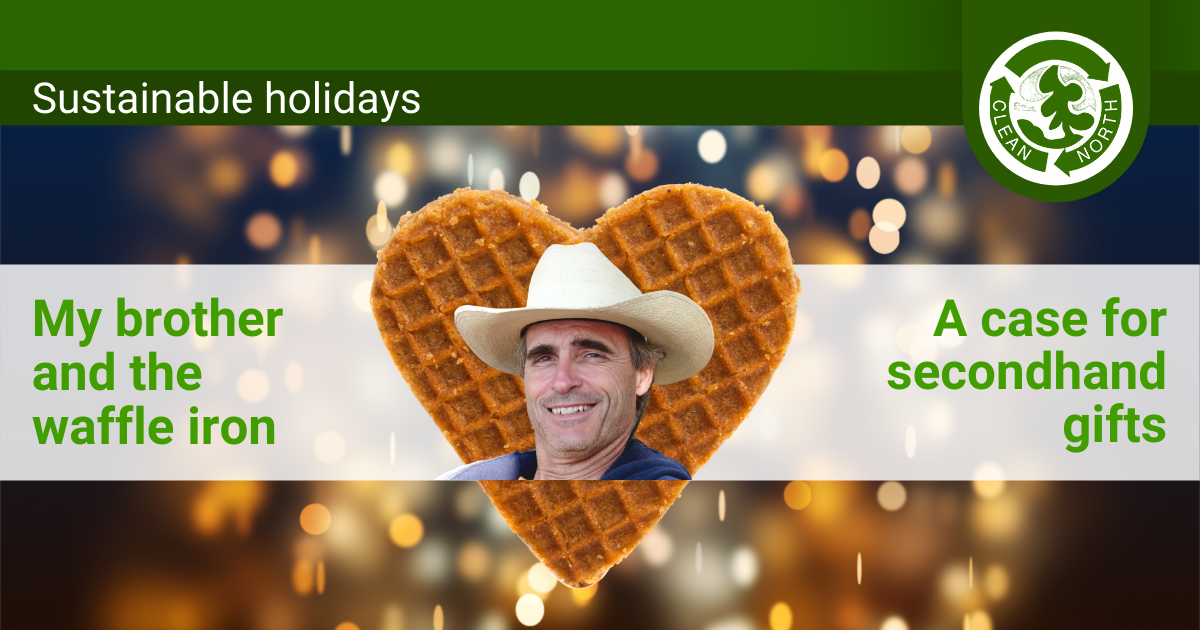
By Clean North volunteer Abby Obenchain
Have you ever given a secondhand gift? Or do you think that if you give a gift that’s not brand spanking new, you will be thought of as a cheapskate or seen as tacky? To help protect the environment and fight climate change, we need to change this mindset.
I come from a family with a rich tradition of secondhand gifts. My favourite thrift gift story involves my late brother, Riley Obenchain, and a waffle iron. I love waffles, and many years ago I asked for a waffle iron for my birthday. Riley, who was the waffle king of our family, went to Kmart and bought me one. On his way home, he stopped at a yard sale and discovered a waffle iron priced at a mere $1! He bought the yard sale waffle iron, returned the $40 Kmart one…and had so much fun telling me this story when I opened the used waffle iron. I have thought about this story many times over the years, and it always makes me smile. That used waffle iron, by the way, lasted me many years.
Here’s a more recent secondhand gift story. Earlier this fall, my husband drove out to visit our son who lives in a tiny rural town in eastern British Columbia. Our son is on a tight budget and lives far from stores, so before my husband left, I went to a thrift store and bought almost an entire wardrobe for what a few items would cost at a regular store. Our son was thrilled! Some of the items I found were produced by posh companies like Tommy Hilfiger, Roots, and Gap, all bought for a fraction of their original price.
So what’s the environmental case for buying used gifts?
- Prevents wasting energy/resources making new items. For example, in Sweden, a digital secondhand marketplace called Blocket is reducing fossil fuel emissions enough to offset that country’s transportation-related emissions. What’s more, new items can be water- as well as energy-intensive: Buying a secondhand cotton shirt, for example, can save huge amounts of water — growing just one kilogram of cotton takes 20,000 litres.
- Reduces production of new plastic and styrofoam packaging as well as the need to transport items long distances.
- Reduces pollution such as chemicals used to make plastic, cloth, wood, and paper, which often has a disproportionate effect on low-income people living in developing nations.
- Extends landfill life by preventing usable items from ending up being trashed (our landfill here in the Sault is almost full).
- Reduces costs involved in gifting so you have more money for other things like experiences or helping the environment.
- Boosts community development and helps local people in need since many thrift stores are run by charities.
Ok, so you are convinced that buying secondhand is good stuff…but how do you get your family on board? The key is communication. Make a pact with your family that a certain proportion of (or even all!) gifts will be secondhand. If everyone’s doing it, there’s no stigma.
Some tips for shopping thrift:
- Try to shop at locally owned outlets such as St. Vincent Place and the Bargain Box (both on Albert St.). This way, the money you spend stays in the community and often supports good works. I do understand why some people shop at big box thrift stores since they do tend to have better selection — it is still better than buying new.
- Shop thrift online. Local Facebook auction/sale sites are a great place to find great secondhand items.
- Watch for events. Many churches have Christmas bazaars featuring used items, including gorgeous vintage jewellery.
- Don’t forget Habitat for Humanity Re-Store! They carry lots of gently used household items.
Keep in mind that when it’s a gift, you probably do need to be a bit picky about what secondhand items you buy…look for ones that are very gently used, e.g., no missing buttons or pieces, pilling, major cracks/chips, etc.
I hope this post has inspired you to consider shopping thrift this holiday season. It truly is an effective way to reduce unnecessary consumption and create a greener world.
Next I’ll try converting you to my brother Riley’s practice of wrapping gifts in secondhand wallpaper!




